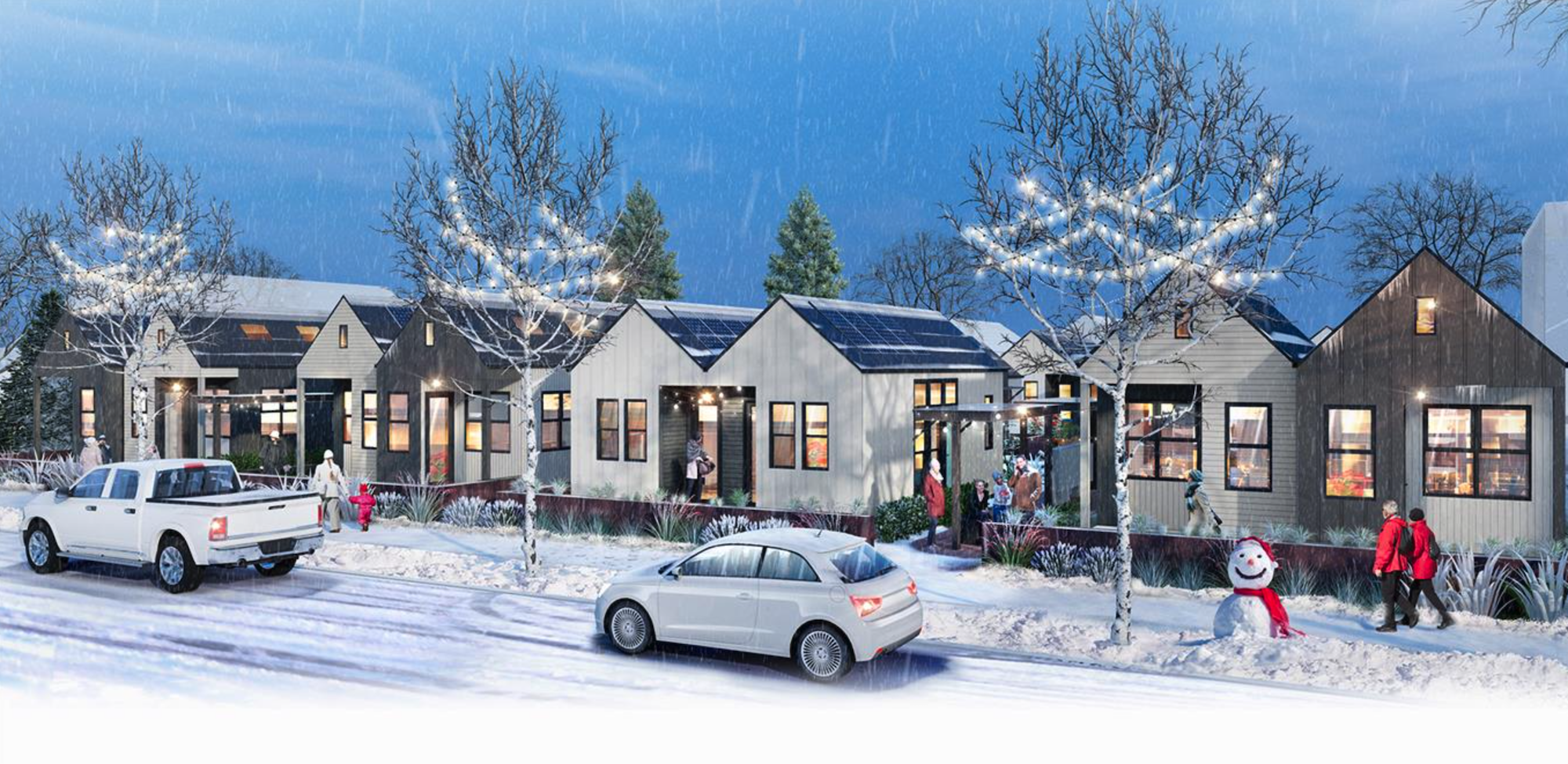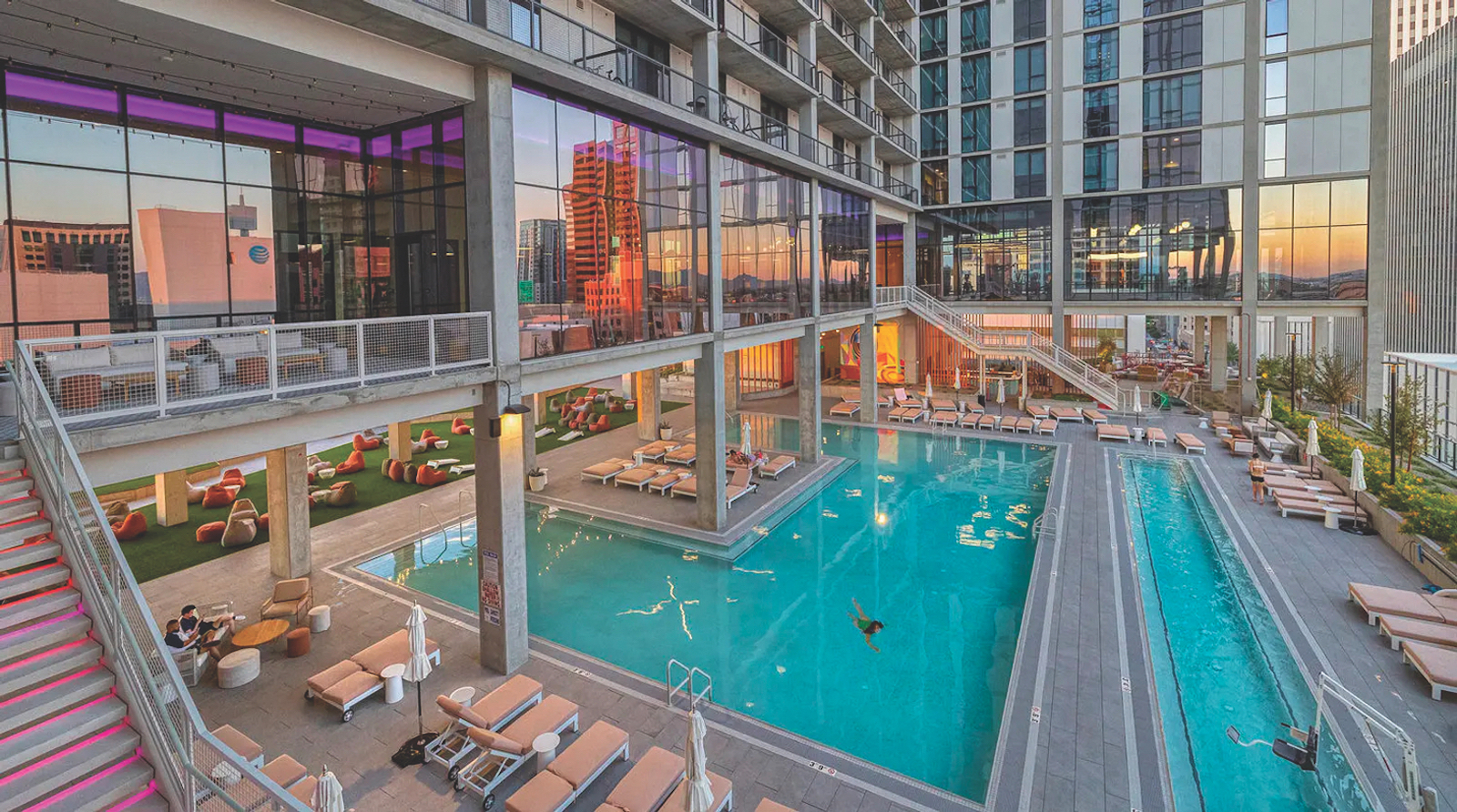The booming multifamily sector shows no signs of a significant slowdown heading into 2023. Here is a round up of Giants 400 firms that are driving innovation in this sector:
Clayco and architecture firm FitzGerald completed the 20-story, 330-unit X Phoenix development, a mixed-use residential high-rise in downtown Phoenix that contains, among other rental units, dedicated space for co-living. This shared apartment model is designed to cater to working professionals seeking convenience, community, and modern shared amenity space at more attainable prices in expensive rental markets. The development also includes an indoor bike mezzanine, 105,500-gallon pool, five-story parking garage, and 50,000 sf of shell space that will include a commercial restaurant.
Dahlin Group developed a tiny home prototype, Mod Hive, to help address the affordable housing shortage in Salt Lake City. The prototype works as a small cluster on one lot or a small, planned development consisting of multiple lots. The concept involves an inward-looking site plan that creates a tiny village with space for a community garden, outdoor gathering space, and barbecue/firepit. It replicates the feel of a traditional neighborhood of two-story, single-family detached homes by employing a lower-density configuration at the front of the lot, with higher densities at the rear.

For another tiny house project, Dahlin collaborated with HomeAid Northern California and Firm Foundation Community Housing to design cost-effective tiny home villages sited on church properties, targeted at individuals facing homelessness. This partnership completed its pilot project in February 2020 with additional projects under development in 2021. In the San Francisco Bay Area, affordable multifamily developers expect to spend $700,000 to $1 million per single one-bedroom unit; the pilot village came in at $150,000-$170,000 per unit, with an entitlement process of just 12-18 months.
Dattner Architects had four Passive House projects progress through construction stages in 2021, with Santaella Gardens completed in late 2021 and receiving Passive House Certification in early 2022. These projects provide replicable models for Passive House applications to multifamily affordable housing. Santaella Gardens provides much needed workforce and affordable housing in the Bronx. Its super-insulated, airtight building envelope includes thermally broken, high-performance windows and advanced air sealing details to eliminate condensation and air exfiltration. Rooftop solar photovoltaic panels generate onsite renewable energy, with a capacity of 162.7 kW. The building has a projected energy use intensity of 20.40 kBTU/sqft/yr.
The Hall Arts Residences in the Dallas Arts District joins HKS’s growing portfolio of projects focused on creating superior spaces for the health and well-being of building occupants. The project is the first residential project in Texas to register for WELL Multifamily Certification.
Morrison Hershfield contributed to the launch of the Embodied Carbon Pathfinder, a free app for quickly estimating cradle-to-grave whole-building life cycle assessment results for multifamily buildings. The tool uses thousands of data points that allow users to find “pathways” through design choices to land on a target embodied carbon result. The project is a collaboration with OPEN Technologies and the Athena Institute.
Related Stories
Urban Planning | Jun 15, 2023
Arizona limits housing projects in Phoenix area over groundwater supply concerns
Arizona will no longer grant certifications for new residential developments in Phoenix, it’s largest city, due to concerns over groundwater supply. The announcement indicates that the Phoenix area, currently the nation’s fastest-growing region in terms of population growth, will not be able to sustain its rapid growth because of limited freshwater resources.
Multifamily Housing | Jun 15, 2023
Alliance of Pittsburgh building owners slashes carbon emissions by 45%
The Pittsburgh 2030 District, an alliance of property owners in the Pittsburgh area, says that it has reduced carbon emissions by 44.8% below baseline. Begun in 2012 under the guidance of the Green Building Alliance (GBA), the Pittsburgh 2030 District encompasses more than 86 million sf of space within 556 buildings.
Industry Research | Jun 15, 2023
Exurbs and emerging suburbs having fastest population growth, says Cushman & Wakefield
Recently released county and metro-level population growth data by the U.S. Census Bureau shows that the fastest growing areas are found in exurbs and emerging suburbs.
Engineers | Jun 14, 2023
The high cost of low maintenance
Walter P Moore’s Javier Balma, PhD, PE, SE, and Webb Wright, PE, identify the primary causes of engineering failures, define proactive versus reactive maintenance, recognize the reasons for deferred maintenance, and identify the financial and safety risks related to deferred maintenance.
Mixed-Use | Jun 12, 2023
Goettsch Partners completes its largest China project to date: a mixed-used, five-tower complex
Chicago-based global architecture firm Goettsch Partners (GP) recently announced the completion of its largest project in China to date: the China Resources Qianhai Center, a mixed-use complex in the Qianhai district of Shenzhen. Developed by CR Land, the project includes five towers totaling almost 472,000 square meters (4.6 million sf).
Mixed-Use | Jun 6, 2023
Public-private partnerships crucial to central business district revitalization
Central Business Districts are under pressure to keep themselves relevant as they face competition from new, vibrant mixed-use neighborhoods emerging across the world’s largest cities.
Multifamily Housing | Jun 6, 2023
Minnesota expected to adopt building code that would cut energy use by 80%
Minnesota Gov. Tim Walz is expected to soon sign a bill that would change the state’s commercial building code so that new structures would use 80% less energy when compared to a 2004 baseline standard. The legislation aims for full implementation of the new code by 2036.
Student Housing | Jun 5, 2023
The power of student engagement: How on-campus student housing can increase enrollment
Studies have confirmed that students are more likely to graduate when they live on campus, particularly when the on-campus experience encourages student learning and engagement, writes Design Collaborative's Nathan Woods, AIA.
Multifamily Housing | Jun 1, 2023
Income-based electric bills spark debate on whether they would harm or hurt EV and heat pump adoption
Starting in 2024, the electric bills of most Californians could be based not only on how much power they use, but also on how much money they make. Those who have higher incomes would pay more; those with lower incomes would see their electric bills decline - a concept known as income-based electric bills.
Multifamily Housing | May 30, 2023
Boston’s new stretch code requires new multifamily structures to meet Passive House building requirements
Phius certifications are expected to become more common as states and cities boost green building standards. The City of Boston recently adopted Massachusetts’s so-called opt-in building code, a set of sustainability standards that goes beyond the standard state code.


















